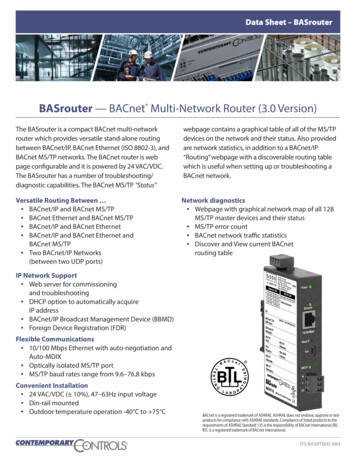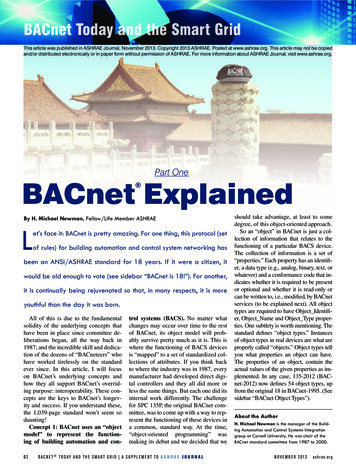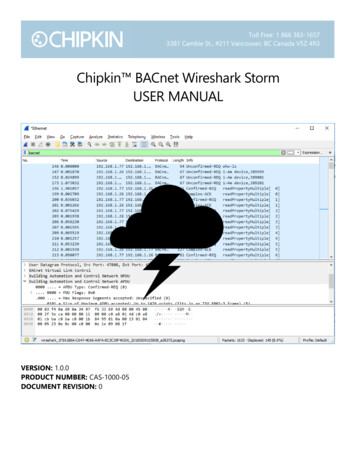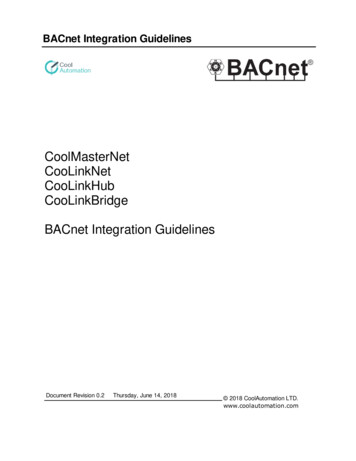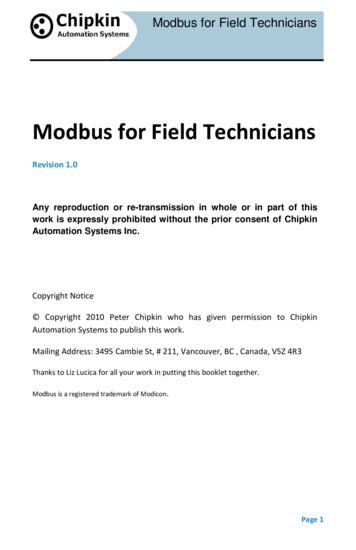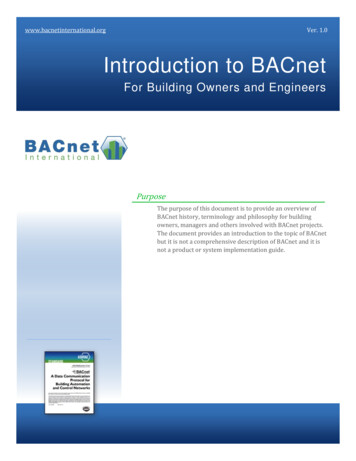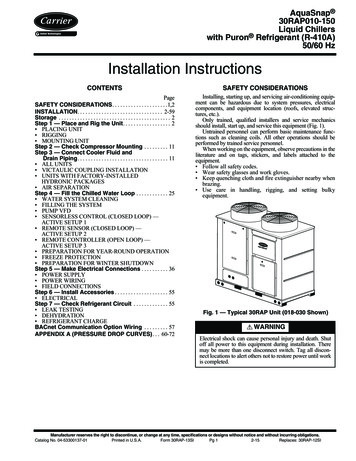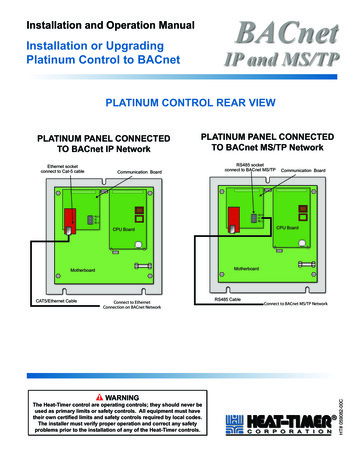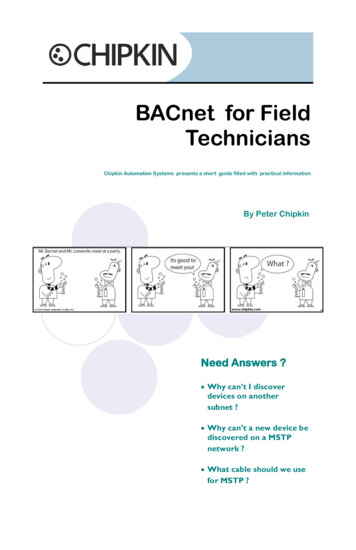
Transcription
BACnet for FieldTechniciansChipkin Automation Systems presents a short guide filled with practical informationBy Peter ChipkinNeed Answers ? Why can’t I discoverdevices on anothersubnet ? Why can’t a new device bediscovered on a MSTPnetwork ? What cable should we usefor MSTP ?
BACnet is a registered trademark of ASHRAELonWorks is a registered trademark of Echelon CorporationRevision 1.0Any reproduction or re-transmission in whole or inpart of this work is expressly prohibited without theprior consent of Chipkin Automation Systems Inc.Copyright Notice Copyright 2018 Peter Chipkin who has given permission to Chipkin AutomationSystems to publish this work.Mailing Addr: 3381 Cambie St, # 211, Vancouver, BC , Canada, V5Z 4R3Thanks to Tim Plumridge our cartoonist.Page 2
Table of ContentsBACnet Objects and Properties4BACnet BBMD connects networks8Segmentation9BACnet Services11BIBB's13COV17MSTP27MSTP Bandwidth Issues33What can go wrong with RS48537MSTP Discovery41MSTP Slaves vs. Masters43Changing the Present Value45Trouble Shooting BACnet IP49Trouble Shooting BACnet MSTP65Hubs vs Switches73Resistors75Page 3
BACnet IntroductionIntroductionBACnet is a building automation and control networking protocol. It was developed by ASHRAE. BACnet was designed specifically to meet the communication needs of building automation and control systems. Typical applications include: heating, ventilating, and air-conditioning control, lighting control, accesscontrol, and fire detection systems.History and BackgroundWho cares. It works. It’s open and it’s growingFlavors Of BACnetClarificationNative BACnet – What does that mean? Inthe Building Automation world the term‘Native’ means that a device supports thatfunctionality / protocol without the additionof a gateway or other module.FlavorApplicationUses the IP protocolPoint to Point MS/TPARCnetIPEthernet 802.3Page 4Controller to controllerController to HMIAffects you ?On the upSome field devices.Raw Ethernet PacketsBeing displaced by IPModems and phone linesRare. Expect to disappear Field DevicesMillions of installed devices. Controller to controllerRare. Expect to disappear
BACnet Objects and PropertiesThis is an objectObject:Type: Binary InputInstance Number: 1Name: Operating StatusPresent Value: 1Object:Type: Analog InputInstance Number: 1Name: Room TempPresent Value: 73.0Object:Type: Analog ValueInstance Number: 1Name: SetpointPresent Value: 74Object:Type: Binary ValueInstance Number: 1Name: Use Remote SetpointPresent Value: 1This is the 'Device' objectThe propertiesdefine the BACnetinterface.These are thepropertiesObject:Type: DeviceInstance Number: 3Vendor Identifier: Apple IncSegmentation Supported: 0x03Page 5
BACnet Objects and Properties cont’dData inside a BACnet device is organized as a series of objects. Each object hasa type and a set of properties. There is always at least one object in a device – itis used to represent the device itself . The other objects represent the device’sdata.In practical terms think of a simple thermostat. Our example is a simple devicethat has a temperature sensor, allows the set point to be changed locally orremotely, has a local remote selection and reports there is an internal fault byreporting its status as normal/abnormal.Useful TipThe device object is the first object readafter a device is discovered because it has lotsof interesting information for the client. Forexample, the device object has properties thatreport whether the device supports COV,whether more than one property can be readin a single message.Useful TipUnique Numbers are required for BACnetDevice Object Instance Numbers across theentire network, but in practice, you can useduplicates as long as routers separate thenetwork segments the duplicates are connected to.Heads UpSome vendor systems and controllers requireeach object within a device to have a uniquename. This is because they use the name asan internal index key (We agree that isstupid).Page 6
BACnet Objects and Properties cont’dCommonly used properties - Almost all objects you encounter will havethese (and more) properties.Object Type:Popular Object Types: Analog Input, Analog Output,Binary Input, Binary Output.Instance Number:A number that must be not be repeated for any otherobject of the same type. The instance number and theobject type must be unique for every object in a device.Name:Speaks for itself.Present Value:The current value of the object. BACnet has ways oftelling you if the present value is valid – it uses a property called ‘Reliability’.Example of the properties and their values for a BACnet data object.object-identifier:analog-input [180]object-name:One sec Ph 00000status-flags:In-Alarm [false], Fault [true], Overriden [false], OutOf-Service herout-of-service:Falseunits:Voltsdescription:Zero length/empty stringPage 7
BACnet Supports DiscoveryIn Modbus you need a data sheet to know what data is inside a field device. InBACnet you don’t. You can go-online and discover the devices on a networkand then interrogate the devices so they report what data objects they containand what properties each object supports and what the current state of eachproperty is.The ability to discover is an almost universal truth in BACnet but there an obscure technicality may limit what you can learn about the object properties –Devices that support Read-Property-Multiple and don’t support segmentationmay not be able to fill in the response into a single message and thus don’t respond with useful information.We should also mention that most ‘Discoverers’ (or clients as we like to callthem) cannot discover Vendor created proprietary properties.There are two important practical implications of discovery:1. If your client software is half decent you do not have to type object/properties into the configuration screens. You simply discover and then dragand drop. Unfortunately more than half the BACnet software out there is nothalf decent.2. You would think you can get away without data sheets but again you are thendependent on how decent a job the device Vendor did in naming and describingtheir points. Bad naming, missing object descriptions, un-implemented properties like max and min values make your job harder and force you to use Vendordocs.Useful TipTo discover devices on a foreign subnet youcan configure the router to forward broadcasts or you can use BBMDPage 8
BACNET BBMD connects networksThe BACnet discovery uses two services - called ‘Who-Is’ and ‘I-Am’. They relyon the use of broadcasts.Heads UpRouters join IP networks together so messages from one network can be sent to another.Most routers do not forward broadcast messages and this means discovery cant discover devices on another network.Routers join IP networks together so messages from one network can be sentto another. Most routers do not forward broadcast messages and this meansdiscovery cant discover devices on another network.To solve this problem BACnet provides a technology called BBMD - BACnet/IPBroadcast Management Device.In overview the technology is simple. You install a BBMD (might be a physicaldevice or just a software application on a computer) on each network. You canconfigure the BBMD by specifying the IP Address and mask of the each BBMD.This makes both BBMD configs identical. When the one BBM receives a broadcast, it forwards the messages to the other BBMD which in re-broadcasts on theother network. They are configured by BDT files and these may be modified onthe fly using selected BACnet services.The technology also provides for foreign device registration. This allows a device on one network to communicate with a device on another network byusing the BBMD to forward and route the messages.Page 9
Segmentation in BACnetSegmentationBACnet messages that don't fit in a single packet use segmentation. Why wouldone message need more than one packet ? Well IP packets have a maximumlength of 1500 bytes. So if you are sending a BACnet IP message that is longerthan 1500 bytes then you need to send more than one Ethernet packet.Example: Ask your fishing buddy if he wants another beer. The reply is short andfits in a single response packet. Yes. Now ask him to tell you about the one thatgot away. He will need multiple sentences to tell you the long story. Your buddyneeds you to support segmentation otherwise you will only hear the first sentence of his story (lucky you.)Be Aware1500 is not a hard coded Maximum Transmission Unit (MTU) length in all Ethernet applications. Often the size is set smaller.Most serial protocols like MS/TP choose a small number for the MTU becausean error requires retransmission and the data is slow so it better to catch anerror in smaller packet.How does Segmentation affect you as a user ?If a device has a large number of objects and a message is sent to read the objectlist then it is possible that the response wont fit in a single packet. If both thedevice and the requestor support segmentation then there is no problem. Ifeither side doesn't support segmentation then 1) You are out of luck or 2) Therequestor must use a different method to read the object list - for example,reading each object using its index until it reaches an index number with noobject.The CAS BACnet explorer works like that - first it tries the most efficient method and then it slowly downgrades itself to try and ensure the response will fit ina single packet. Not all software works in this intelligent manner.Page 10
Segmentation in BACnet cont’dHow do you know if a device supports segmentation ?You can read the vendor's PIC (Protocol Implementation and Conformance)Statement or you can look at the device object's properties.segmented-both (0),segmented-transmit (1),segmented-receive (2),no-segmentation (3)How can you work around the segmentation issue ?Ensure you use read-property for a single property - avoiding read-property forall properties. If you have to use read-property-multiple then limit the list ofproperties to be read and avoid reading all using this service. This might not bepossible if you cant configure which services get used by your system.Page 11
BACnet ServicesThink of a service as a task / action. Reading and Writing data uses some of theBACnet services known collectively as Data Access Service.BAS systems interact with BACnet devices and objects using these services andfor the most part the actual service used is hidden from the engineer building /using the BAS.When would you take an interest in what services are supported ? From ourpoint of view (as user's of BACnet) now we can make the equation Services Capabilities.Example: BACnet provides a service called 'CreateObject'. Most field devicesdo not support this service. Imagine that a BAS vendor provides an option to'Create a new object in Field Device'. You try it and it produces an error sincethe device doesn't support the service. If you are fortunate the BAS you areworking with will provide an error message that tells you why there was anerror.This is the point where the services supported by the BAS and the field devicesbecomes interesting to you. The place to look to see what services a devicesupports is in the vendor PIC statement. There is only one mandatory service Read Property Service.Unfortunately because the actual services used by a BAS are hidden beneath theGUI it's not always easy to know if you can exploit the capability of a field device.Page 12
BACnet Services cont’dUseful TipReadPropertyMultiple - Reads one or moreproperties from one or more objects BUTthere is a catch. If segmentation isn't supported then the reply must fit in a single transmission unit (typical effective for Ethernet is 1500 bytes and for MSTP 245 bytes. ) This is a fundamental weakness in BACnet since you cant know in advance how big the responsewill be. A number of (cleverer) clients will use ReadProperty to readeach item when a ReadPropertyMultiple failsServiceNotesAddListElement ServiceRarely supportedRemoveListElement ServiceRarely supportedCreateObject ServiceRarely supportedDeleteObject ServiceRarely supportedReadProperty ServiceAlways SupportedRarely supported - Returns a list ofobjects/properties that meet the speciReadPropertyConditional Servicefied selection criteria. E.g. all AnalogInputs.ReadPropertyMultiple ServiceOften supportedReadRange ServiceRarely supportedWriteProperty ServiceAlmost always supportedWritePropertyMultiple ServiceLess often supported than ReadPropertyMultiplePage 13
BIBB’sThe implementation of BACnet is under-the-hood. It is invisible to most of ususers. We don't know what services are supported and nor do we know wheneach service is used. If we don't know then how can we tell, for example,whether a controller and field device such as a thermostat can interact.The question is: How do you match requirements of a project to the capabilitiesof the devices being installed ? The Answer - in BACnet - is BIBBS.A BIBB is a BACnet Interoperability Building Block.Continuing with our example: Say your controller needs to read the set pointon a thermostat to perform its control. Then the controller needs to support aBIBB called DS-RP-A. This isn't enough. The thermostat must be able to respond so it needs to support a BIBB called DS-RP-B. DS stands for Data Sharing. RP stands for Read Property. The A and the B stand for Client (A) and Server (B).The outdoor temperature on a HVAC controller could come from two places.A local sensor connected to the unit or a remote value sent via BACnet. In thiscase you would want to match the BAS controller and HVAC controller withBIBBS DS-WP-A and DS-WP-B (DataSharing-WriteProperty-A or B for Clientand Server).Thus, if you buy a great controller that supports Conditional and Range Readsyou would want to buy field devices that support these services. DS-RPC-A/Bfor AbbreviationBIBB CategoryDSData SharingAEAlarm and Event ManagementDMDevice ManagementNMNetwork ManagementTTrendSCHEDSchedulePage 14DM and NM are part of the same category.
BIBB’s continuedUseful TipDevice A and Device B. All the BIBBs end in'-A' or '-B'. BACnet refers to the A deviceand the B device. The A device in this contextis a device acting as a client. The B devicemeans a device acting as a server. In BACnetdevices can be both clients and servers sincealmost all devices can read data from each other.Extract – The full BIBBS table is available at -bacnet-interoperability-building-blocksBIBB CategoryBIBBNotes / Description of thefunctionality provided.List of BACnet Services that mustbe supported. Initiate usuallymeans ‘send a message’ Execute usually means ‘process andact on a message’ and oftenmeans ‘send a response’Page 15
PIC StatementsThe BACnet specification defines theoretical capabilities. The PICS statementtells you what capabilities have been implemented.Every BACnet capable device (Controllers, Software and field devices) has aPICS statement. The PICS statement is very useful to you as a Field Tech, Engineer or designer.VendorDevice ProfilesSegmentationStandardObjectsPage 16BIBBS
Blank PagePage 17
BACnet Change of Value (COV)IntroductionMost field devices are passive servers. They wait passively for a system to pollthem for data and only then do the devices respond. A consequence of this isthat the data client only knows the value of an object property when it polls forthe value. If the duration of an event (change of value) is shorter than the interval between polls then the data client will not know the event occurred.BACnet provides a solution for this by defining services to report events. Theseservices allow a device to be transformed from a passive server to an activeserver since it is now capable of sending messages reporting the value of anobject property based on some event rules. BACnet COV is a sub-set of the'Alarm and Event Services'.Client SystemServer DevicePollResponseSubscriptionNotificationPage 18
This article discusses how the technology operates and then provides a discussion on some weaknesses in the COV system.BACnet provides a solution for this by defining services to report events. Theseservices allow a device to be transformed from a passive server to an activeserver since it is now capable of sending messages reporting the value of anobject property based on some event rules. BACnet COV is a sub-set of the‘Alarm and Event Services’.Simple Definition of COVData clients subscribe to an object for COVreporting. The device monitors the value ofthe object property, monitors the subscription list and the change criteria. When thechange criteria are met the devices sendsnotifications of the new value to the subscribers.Useful TipNot all devices / objects support COVThe BACnet COV system is not a mandatorypart of the protocol. Each vendor decides ifthey want to support it. In addition, each vendor gets to decide which properties of whichobjects support COV.The device object of a COV server indicates whether there is supportfor COV. Beyond that you have to look for the presence of certainPage 19
How COV WorksThe system is a little more complex than these note describes. For example,subscriptions have durations and there is more than one way the notificationcan be sent,SubscribeData Client sends messages to the device to subscribe to COV notifications.The server must accept the subscriptionCOV ServerCOV ClientSubscribe to Object(SubscribeCOV-Request)Subscribe to Property(SubscribeCOVProperty-Request)MonitorCOV Server device monitors the property values of subscribed objects and theCOV change criteria.Page 20
How COV Works cont’dNotifyWhen a change has occurred that meets the COV change criteria the serversends notifications to the subscribers or for those objects with a COV Perioddefined, notifications are sent based on the period if there has been no change.Process NotificationCOS ServerCOV ClientUnconfirmedCOVNotification-RequestAnalog Input'Status Flags''Present Value''COV Increment'ConfirmedCOVNotification-RequestThe data client must process the notification and update the display, log .Unsubscribe / Renew SubscriptionIf the data client no longer needs the subscription it unsubscribe. If it needs thesubscription maintained then the client should periodically re-subscribe.Page 21
Key Elements of the COV TechnologyCOV Server :A BACnet device that supports COV, accepts subscriptions and sends COVnotifications messages to a COV Client.COV Client :A BACnet device, typically a SCADA or Logging application, which can subscribefor COV notification and which can process the notification messages.Subscription :Establishes a relationship between a COV Server and a COV Client.Subscriptions have the following attributes ;Subscription to an Object or to a PropertyBACnet provides two services for subscription. One subscribesto an object and the other to a property of an object.Identification of the SubscriberThe server needs to know where to send the notifications.Object IdentifierE.g. Analog Input 1If subscribing to a property then the property must be identifiedtoo.LifetimeIs indefinite or a specific number of seconds. Values can be large.Notification TypeNotification can be sent with/without requiring confirmation fromthe data client.COV IncrementThis parameter is only used in subscriptions to object properties.If not specified in the subscription the object uses its own increment.Notification :A message which reports the current value of the changed property as well asthe current state of the objects Status Flag property if it exists. The notificationalso contains the number of seconds remaining to the subscription. Confirmednotifications require a response from the COV client.Page 22
COV Change CriteriaUseful TipThe device needs to send notification of achange to you. How does it decide when todo this ? You have some control—specify theCOV Increment when you subscribe. Youshould also consider the object and propertytype because there are different rules forwhen they send notifications.The change criteria are based on the type of subscriptionSubscribe to the object :Either of these changes trigger notification1) If the status flags change at all2) If the Present Value changes Binary, Life Safety and Multistate Objects : any changeto Present Value - Analog, Loop and Pulse Objects: change byCOV IncrementSubscribe to a property :Either of these changes trigger notification1) If the status flags change at all (if the object has status flags)2) If the Property Value changes Property is of type REAL : change by COV Increment( which may be defined in the subscription or may bethe native increment defined in the device). - Property is of some other type: any change to PresentValuePage 23
COV Issues and LimitationsGeneral DiscussionThere are some intrinsic problems with event or change reporting systems.In our experience it is fairly common to learn that a well configured systemfailed to deliver the critical information only after a significant failure. We learnthe hard way that we polled for data too slowly, the logger was offline when thenotification was sent or that the logger was swamped with data because of thefailure of incoming feed. With this in mind we draw your attention to some ifthe issues you should consider.The deluge of changes problemThese event reporting systems are commonly implemented to reduce the bandwidth requirements for monitoring remote devices or to ensure that the dataclient sees changes whose durations are less than their minimum polling interval.When a client reduces the frequency of its polls for data or reduces which objects it polls this reduces the bandwidth requirements of the system. To compensate for the lower frequency of updates a COV system may be employed.If COV systems are employed to 'guarantee the delivery of critical data' greatcare should be taken is assessing the so called 'guarantee'. The guarantee isoften based on the assumption that changes are infrequent and small in scopebut this isn't always the case. Often a single change can spawn a number ofchanges and those changes can spawn more changes in a system similar to anuclear reaction. The more changes that occur the more notifications that mustbe sent. If all the changes occur in a short interval then it easy to foresee a situation where a network or data client can be deluged with notifications. Now wehave to assume there is enough bandwidth to handle sending them all and thateach client can handle all the incoming messages quickly. If the notifications require confirmation then the speed of the client in processing the messages ismaterial. If there is no notification required then it is conceivable in a poorBACnet implementation that the client could drop messages when its buffer isfull.It is very difficult to test these conditions because the test requires monitoringlarge data sets and the test setup requires a knowledge of how changes canspawn other changes within a device and / or a system. A consequence of thesedifficulties is that the performance of COV systems can be unpredictable.Page 24
COV Issues and Limitations Cont’dThe offline Subscriber problemA subscriber may be offline when a notification is sent. If the subscription required confirmed notification then this could present a temporary but significantloss of bandwidth while the COS server waits the timeout period before sending the next notification. If no confirmation was required then there is no way ofknowing that the subscriber was offline and even if it wanted to the COS serverdevice cannot signal this in anyway.The COV system does not require vendors to manage notifications sent tooffline subscribers. Thus the COV server does not have to queue them andresend them. Thus, it is possible for a COV client to lose its data synchronization with the Server. The only way around this is to use occasional polling.However, if the data client was a logging system then the damage is already doneand the log records will not be made.Useful TipThe device needs to send notification of achange to you. How does it decide when todo this ? You have some control—specify theCOV Increment when you subscribe. Youshould also consider the object and propertytype because there are different rules forwhen they send notifications.Page 25
BACnet COV LimitationsSubscriptions may be lost on resetThe BACnet spec does not require vendors to maintain the subscriptions if thedevice resets. Thus a reset may result in the loss of all subscriptions. Now thesystem is dependent on the frequency of the re-subscription by the data client.That frequency is a vendor choice too and some systems don't send periodic resubscriptions.Single/Multiple SubscriptionsA single data client can potentially subscribe more than once to the same dataobject. This is possible because in identifying itself, in the subscription, the clientprovides two elements of information - identifier and handle. The identifier tellsthe server where to send responses. The handle is a number allocated by theclient for some internal purpose. Changing the handle is enough to make a subscription unique and hence it is possible to have multiple subscriptions to thesame object from the same client.Subscribing to ArraysThe spec allows vendors to choose whether to support subscriptions to all orparticular elements of the array.Variable Number of SubscriptionsEach vendor chooses how many subscriptions to an object / property are supported. The spec requires that at least one must be supported. You should assume the list is finite and fairly short.Its conceivable that subscription space could be wasted by temporary subscriptions from test equipment of software thus denying room for important subscriptions.It is important to understand how your COV client application handles and reports failed subscriptions as these events can be as important as the event theyare attempting to monitor.Page 26
COV Issues and Limitations Cont’dUnconfirmed Notifications can be sent without SubscriptionThe spec allows a device to send unconfirmed notifications for any property ofany object to any other device on the network. Thus a device can send changesof a object property that has a wide area interest such as an outside air temperature. The vendor chooses if they wish to implement this, which objects, whichproperties and the frequency of the notification.Notifications can be sent without a change of valueThe criteria for triggering notification messages requires notifications to be sentif the Status Flags associated with the object change even if the value hasn'tchanged. This is potentially, important information but a number of data clientsystems ignore this element of the notification data.Warning !There are some risks to using COV. Readthe notes on these pages to learn about them.We strongly recommend that you test thesystem to avoid being burned by assumptions.If data is critical then poll for it as well as using COV.Page 27
MSTP— An IntroductionThis flavor of BACnet is most commonly used to connect field devices to controllers / routers / control applications.MSTPM MasterS SlaveTP Token PassingThe physical layer uses RS485 which allows up to 128 devices to be installed ona single network with a max physical length of 4000ft and speeds up to 115kbaud. Using repeaters allows the length to be increased. Compare to Ethernetwhere the spec allows a max of 100 meters (330ft) on a single unrepeated segment.Common baud rates are 19200, 38400 and 76800. All devices must operate atthe same baud rate. More and more devices can auto sense the baud rate andconfigure themselves correctly.Warning !A number of microprocessor UARTS cannotaccurately produce 76800 baud signals. Devices using these microprocessors might list76800 as supported. If you are having issuesyou might want to downgrade your network.We divide the messages on a MSTP network into two categories Overhead (token, poll for master ) Application. These carry payloads that we have an interest in.Only a device with the token can initiate an application layer message. It cansend the message to any device on the network. Some messages demand aninstantaneous reply, some don’t. The receiving device doesn’t need the token torespond. There is a limit to how many application layer messages a device cansend before it must pass the token on. (The limit is implied by the max numberof frames that can be sent before the token is passed. ))Page 28
MSTP— An IntroductionThe benefits of token passing networks are the following1.2.3.They are self healingThey can discover new devicesThey ensure each device gets its chanceThey avoid collisions making network performance (somewhat) deterministicA disadvantage of the token system is that any one device gets a limited use ofthe bandwidth. Thus a device may need to keep an internal queue of applicationlayer messages it wants to send, waiting to use the token. We have encounteredsome vendor systems which fill there queue and then drop subsequent messageswithout notifying the user of the problem. Limited access combined with theoverhead makes it easy to use up all the bandwidth on the network if there aremany devices with many objects and many properties of interest.Page 29
BACnet MSTP Installation and RS485Here is our simplified advice :RS485 is a 3 conductor network.You take a huge risk by not installing the 3rd conductor. You risk blowing 485ports, you risk unstable operation (works sometimes and doesn't work othertimes) and finally you risk re-installation. For a more detailed discussion readthis article ou-need-3-wiresfor-2-two-wire-rs485 . The more power sources used to power devices, thegreater the physical separation of devi
BACnet was designed specifically to meet the communica-tion needs of building automation and control systems. Typical applications in-clude: heating, ventilating, and air-conditioning control, lighting control, access control, and fire detection systems. History and Background Who cares. It works. It's open and it's growing Flavors Of BACnet
